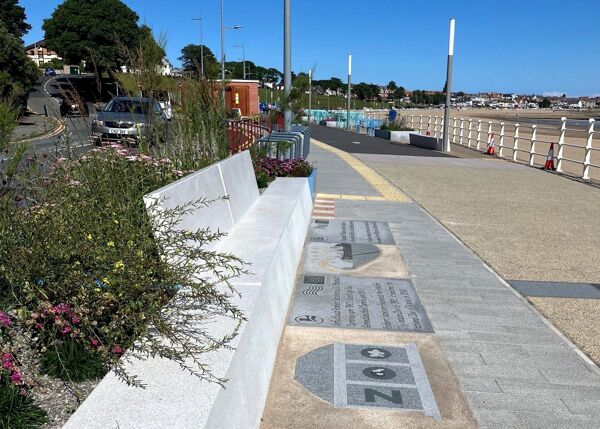
NEC has been used to introduce a free-flow electronic tolling system called HKeToll on three major road tunnels in the New Territories of Hong Kong. The works were undertaken as part of two six-year NEC3 Term Service Contracts (TSC) which the Highways Department (HyD) of the Government of the Hong Kong Special Administrative Region of China awarded to Welcome Construction Company Ltd and Gammon Construction Ltd in 2019 and 2022 respectively.
The HKeToll system, which has now been adopted for all government tolled road tunnels in Hong Kong, was successfully implemented on time and within budget on the 2.6 km long Shing Mun Tunnels and the 1.4 km long Lion Rock Tunnel in May 2023, and on the 4 km long Tate’s Cairn Tunnel in November 2023. The HK$38.2 million (£4 million) project was procured as task orders in HyD’s NEC3 TSCs for management and maintenance of expressways and high-speed roads in the New Territories.
Being part of the Hong Kong’s smart mobility initiative, HKeToll now automatically collects tolls from vehicles using these three tunnels via vehicle tags. Motorists no longer need to switch lanes, queue or stop to use toll booths, resulting in reduced congestion and smoother traffic flow near the tunnel portals.
HyD was the TSC service manager for the multi-disciplinary contracts, which covered civil engineering and electrical and mechanical (E&M) works as well as non-engineering activities. Civil engineering works included implementation of multi-staged temporary traffic arrangements to form free-flow traffic lanes; demolition of toll booths, islands and canopies; and modification of road markings and traffic signs. The E&M works included development of back-end data acquisition systems and installation of radio frequency identification detectors and cameras. Non-engineering activities included amendments to legislation and distribution of vehicle tags to motorists.
Collaborative approach
Benjamin Chan, regional highway engineer of HyD’s New Territories Region, says HyD played a vital role in implementing the civil engineering works and collaborated with parties from other disciplines to identify and resolve interfacial issues. ‘In line with the NEC requirement to act in a “spirit of mutual trust and co-operation”, all parties shared a collaborative “one team, one goal” approach, which was indispensable to the success of this complex project.’
He says the prime objective was to minimise public disturbance. ‘The client, service manager, contractor and subcontractors shared a common goal to complete the HKeToll switchover works within a few hours on a Saturday night, when traffic volumes were low. This included modification of road markings and traffic signs, covering toll booths and implementing multi-staged temporary traffic arrangements.’
Chan says given the anticipated long vehicle queues during the full closure of tunnels, the project team was tasked to complete the final stage of the switchover works, such as uncovering HKeToll-related traffic signs and forming the free-flow traffic lanes, within a very tight timeframe. ‘This was just 30 minutes for Shing Mun Tunnel and Lion Rock Tunnel and 1 hour for Tate’s Cairn Tunnel.’
He says the project team held collaborative workshops with authorities such as the Transport Department and tunnel operators throughout the project delivery cycle to resolve interfacial issues. ‘Examples included on-site verification by test vehicles of the proximity of civil engineering works, and formulating a combined civil engineering and E&M works programme for progress monitoring. With the project team’s united efforts, the HKeToll switchover works were completed on time and within budget.’
No blame culture
Allen Poon, senior engineer of HyD’s New Territories region, says a ‘no blame’ culture was promoted across all levels of the project team to encourage members to express ideas willingly. ‘For example, smartphones with instant-messaging apps allowed people to exchange information instantly and record these exchanges. To keep the senior management updated with the progress, the project team also used instant messaging instead of emails for progress reporting.’
He says site supervisory staff further used their smartphones to take time-stamped photographs for accurate progress management. ‘Moreover, supervisory staff suggested using designated task codes instead of full descriptions of tasks for simplified and accurate progress reporting.’
Poon says the project team held regular meetings and workshops to build up the collaborative and no-blame culture, thus fostering resolution of critical issues and optimisation of workflows. ‘These events also helped establish a common goal of delivering quality switchover works on time and with zero accidents and environmental nuisance.’
Successful showcase
 Chan concludes, ‘Implementing the HKeToll at Shing Mun, Lion Rock and Tate’s Cairn Tunnels was a successful showcase of a collaborative and multidisciplinary fast-tracked project. Although the project team encountered numerous challenges in the project delivery cycle, the result of HKeToll was well received by members of the public.’
Chan concludes, ‘Implementing the HKeToll at Shing Mun, Lion Rock and Tate’s Cairn Tunnels was a successful showcase of a collaborative and multidisciplinary fast-tracked project. Although the project team encountered numerous challenges in the project delivery cycle, the result of HKeToll was well received by members of the public.’
He says the quality of living has been remarkably improved by the reduced travelling time and enhanced riding comfort. ‘HKeToll is a milestone of smart transportation development, marking the beginning of a smarter, more livable and vibrant Hong Kong.’
Project highlight video
Benefits of using NEC
- NEC flexibility enabled this relatively small but complex multi-disciplinary project to be procured on time and within budget using task orders within term management and maintenance contracts.
- NEC requirement to act in a ‘spirit of mutual trust and co-operation’ led to all parties sharing a collaborative ‘one team, one goal’ approach.
- NEC-inspired collaboration included adoption of a ‘no blame’ culture, with which individuals were encouraged to share ideas for the benefit of the project.




